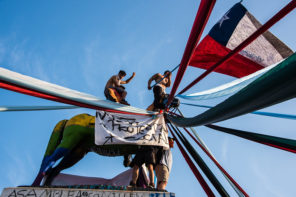This summer, Allegra has been particularly inspired by the intricacies of global bureaucracies. Our readers may have already read the report of the workshop ‘The Bureaucratization of Utopia’ Allegra co-organized with the Graduate Institute in Geneva or watched the short introductory videos featured on Allegra TV. To continue our exploration of paperwork, audit cultures and administrative subjectivities, we now share with you this series of two posts that take the form of Minutes of (virtual) Meetings with the editors of two recent publications on ‘meeting ethnographies’. Over the past two months, Allegra’s director of stuff, Julie Billaud, convened two online meetings with Renita Thedvall, Jen Sandler, Hannah Brown, Adam Reed and Thomas Yarrow to discuss the insights they gained by exploring this ubiquitous modern practice. Here is what came out of their conversations.
Date: 13 June 2017
Chair: Julie Billaud (JB), Director of Stuff, Allegra Lab
Participants:
- Renita Thedvall (RT), Stockhom University
- Jen Sandler (JS), University of Massachusetts, Amherst
- Hannah Brown (HB), Durham University
- Adam Reed (AR), University of Saint Andrews
- Thomas Yarrow (TY), Durham University
Purpose of the meeting: Discuss two recent publications on ‘meeting ethnography’ :
- Thedvall and Sandler (2017). Meeting Ethnography: Meetings as Key Technologies of Contemporary Governance, Development and Resistance. Routledge.
- Brown, Reed and Yarrow (April 2017). Meetings: Ethnographies of Organizational Process, Bureaucracy, and Assembly. JRAI. Vol 23 (S1).
Agenda:
- Understand anthropologists’ neglect for meetings as ethnographic subject of inquiry: The meeting has become an ubiquitous practice, an experience that belongs to the everyday of many people around the world. Why has it taken so much time for anthropologists to look at what goes on in meetings?
- Discuss Schwartzman’s legacy: All of you seem to have been inspired by Hellen Schwartzman’s book The Meeting: Gatherings in Organizations and Communities published in 1989. Could you let our readers know which of her ideas you found particularly appealing to discuss meeting ethnography? How does Schwartzman’s work distinguish itself from other ethnographic accounts of governance and bureaucracy?
- Explain the importance of performance in meetings: Many contributions in your respective edited volumes focus on the performative quality of meetings, as spaces for rehearsal, for building trust or asserting legitimacy via ‘rituals’, as ‘equally available speech acts’ etc. Why do you think such an emphasis is important to understand the nature of power as enacted in meetings?
Minute of Meeting:
1. The meeting has become an ubiquitous practice, an experience that belongs to the everyday of many people around the world. Why has it taken so much time for anthropologists to look at what goes on in meetings?
JS and RT: Some possible obstacles to taking meetings seriously as objects of ethnographic inquiry have likely been the personal aversion to anticipated tedium, the dread and loathing of meetings that so many academics experience in their own day-to-day lives, and an internalization of the popular trope of meetings as a waste of time or a distraction from “real work.” Furthermore, our reading of the intellectual trajectory is that the creative conceptual space that Schwartzman’s seminal study might have opened up was quickly foreclosed by a scholarly rush to account theoretically for the “new” information age: networks, flows, movements.
TY: I certainly share that dread of the tedium of meeting, but wonder if this fully accounts for the lacunae – anthropologists, after all, have not been averse to the study of other mundane and boring practices. For me there are three additional elements to this gap: the first is a methodological one, which is germane to ethnographic accounts of bureaucratic process and expertise more generally: these are often difficult spaces to access and anthropologists have routinely found textual accounts to be easier points of entry. The second is epistemological: as Annelise Riles has observed in relation to documents, we might also say that meetings are ‘too familiar to approach with ease’. That is to say they work through forms and concepts which are also our own and so, paradoxically, elide our analysis. The final point, also linked, is that the form of meetings seems to deflect attention beyond itself, precisely because these are technologies for staging contexts. As anthropologists, and I include myself here, analysis more readily focuses on the substance of that context – perspectives staged, issues discussed on so on – rather than on the mundane forms that generate this.
AR: Yes, I concur with these last points that Tom raises. In fact, if I remember correctly, Riles’ work in the volume Documents starts from a premise that we need to move beyond simply reducing documentary forms to strategic texts and instead start paying attention to the capacities assigned to the artifactual form itself. I think our special issue of JRAI was in part initially inspired by a similar critique/move with regard to meetings: i.e. what shape could description take if it was not being foreclosed by the expectation that meetings be adjudged first and foremost as strategic actions (with the strategic quality of the meeting often in turn being reduced to discursive ‘content’). In other words, I think we shared an instinctive feeling that some forms of analysis were acting as an impediment to ethnographic description; and as a blockage on the expression of the material on meetings we each possessed.
HB: Tom and Adam have nicely summarised the thinking that led us to working on the JRAI special issue. I think it’s important to add that anthropologists have actually got a long history of being interested in what goes on in meetings. There are lots of important examples, not just Schwartzman’s work. In working on this project I was personally particularly inspired by Gregory Duff Morton’s recent work on meetings among the Movimento dos Trabalhadores Sem Terra in Brazil as well as a good deal of earlier work, especially by Sally Falk Moore in East Africa, and indeed Gluckman’s classic depiction of the meeting on the bridge in Zululand. Another consequence of the ethnographic slippage Tom describes above where meetings have appeared mostly as contexts where broader patterns and issues are revealed, rather than as the contents for ethnographic analysis in their own right, has been a failure to think about meetings comparatively, so it has been unusual to read ethnographic work on meetings that draws on these diverse resources. Schwartzman’s work was truly remarkable in its attempt to do this.
2. All of you seem to have been inspired by Hellen Schwartzman’s book The Meeting: Gatherings in Organizations and Communities published in 1989. Could you let our readers know which of her ideas you found particularly appealing to discuss meeting ethnography? How does Schwartzman’s work distinguish itself from other ethnographic accounts of governance and bureaucracy?
RT: We would not have been able to get from the mostly structuralist accounts of meetings by the early ethnographers to our own post-structuralist understanding of meetings without Helen Schwartzman’s (1987, 1989) classic study of meetings in an American mental health center. In this study, she made the meeting the topic. Schwartzman went beyond previous literature by questioning the assumption that meetings are all about making decisions in service of power structures and ideology. She argued instead that meetings are what generates and maintains the organization. This argument allowed her to examine the components of meetings, whether it be power, speech, format, or tools, and their relationships in particular sociocultural settings. She drew on the work of organizational theorists Cohen, March, and Olsen’s garbage-can theory (1972) to argue that decisions are the result of particular problems, solutions, and participants coming together at a particular point in time—thrown into the “garbage can.” Schwartzman added to this argument by maintaining that the meeting is the actual garbage can. In this way, she diverted from Cohen, March, and Olsen’s task-focused approach by arguing that it was the meetings, not the decisions, that should be the center of attention for our studies. She argued for the salience of “meetings as a form with many effects on our behavior” (Schwartzman 1989: 314). Schwartzman also brought in power and control in way that Cohen, March, and Olsen disregard, arguing “. . . it is the meeting and how it produces and reproduces power relations and systems of control that should be the subject of attention” ( Schwartzman 1989 : 239). Schwartzman viewed meetings as disciplining individuals, organizations, and sectors.
TY: Like Renita I have also been inspired by Helen Schwartzman’s attention to the form of meetings, specifically how what happens ‘inside’ these spaces stages what happens ‘outside’, and how the negotiation of that opposition is itself an achievement of some very mundane but important practices. But for me, as I think for a number of contributors to our special issue, her work added impetus to some ideas that came from a range of sources. As Hannah has already described, the initial inspiration came via my ethnographic engagements and the attention, energy and care my informants gave to this activity. That was the puzzle: why do they spend so much time doing this, and what does this do, even when they also sometimes claimed these were boring or a waste of time. My interest in the forms at work in these contexts drew general inspiration (as so much of my thinking does) from Marilyn Strathern’s. In particular her insistence on starting from the categorical distinctions of our informants, bracketing our assumptions of what a person is and of how they are distinguished from other people, artefacts and so on. Meetings enact a kind of perspectival difference that we often take for granted (people have different perspectives on what is manifestly the same thing), whereas Strathern’s work helps us to understand the specificity and interest of this, and the work required to perform it. What kinds of people, places and things does it take to make a meeting? And what is it that meetings make?
AR: Yes, I absolutely concur that the emphasis placed by Schwartzman on the generative capacity of meetings was a game-changer for anthropological description and analysis. However, as my previous comments suggest, I really came to meetings as a topic of anthropological inquiry from a prior interest in documents. So for me, apart from the simple ethnographic curiosity aroused by consistently but divergently encountering the bureaucratic meeting form in different places and times (in a Papua New Guinean prison, in an English literary society and most recently in an animal welfare charity in Scotland), I was chiefly driven by the question of how the previous work on documents appeared both to simultaneously enable and obscure work on meetings. There was a sense in which meetings needed to be liberated from the documentary form, or at least a sense that that relationship ought to be re-articulated in a more reciprocal manner.
HB: I have to thank Simone Abram for introducing to me to Schwartzman’s work some time after I had begun thinking seriously about meetings. When I came to it, what inspired me about Schwartzman’s writing was not only the idea that meetings could make organisations (rather than the other way around), but also the rich ethnographic sense that one has in her writing of her research participants as perpetually immersed in a never ending calendar of meetings, of there being little left of ‘work’ beyond meetings themselves. These descriptions had strong parallels with my experience of fieldwork with government health managers in Kenya, whose work was almost entirely made up of attending meetings. The idea that meetings were themselves work, and not just occasions through which to get work done, was an important insight that Maia Green and I built on in our contribution to the JRAI special issue.
3. Many contributions in your respective edited volumes focus on the performative quality of meetings, as spaces for rehearsal, for building trust or asserting legitimacy via ‘rituals’, as ‘equally available speech acts’ etc.. Why do you think such an emphasis is important to understand the nature of power as enacted in meetings?
JS: Meetings are ostensibly for information-sharing or decision-making. Historically, western meetings have been presumed, by virtually all anthropologists who studied them before Schwartzman, to be primarily about organizational or civic governance and decision-making. And yet, of course, we’ve all attended many meetings in which it is abundantly clear that all decisions were made from the outset. Thinking about the performative quality of meetings enables us to shift from ultimately instrumentalist questions — was this a good meeting, did it work, even how did it work — to larger questions about what sorts of dynamics are performed through the meeting.
This is a shift to a more Gramscian understanding of power as hegemonic. Meetings are not just about strategy and dominance (though of course often such forms of power can be seen through them). They are ultimately about the rather more subtle forms of producing, demonstrating, mocking, maintaining, contesting, and otherwise interacting with hegemonic power. Meetings are about legitimacy, in a wide variety of ways. Such a perspective enables us to make sense of a lot of the things about meetings that on the surface don’t seem to add up. Why (as Hannah discussed it in her response earlier) do people go to meetings rather than other things that would advance their interests, especially when there is no obvious payoff to their attendance? How do we understand the ubiquity of meetings as a series of frames for human activity, beyond simply looking into each frame to analyze the discursive interactions that take place within?
TY: I agree with a lot of what JS has just said. A lot of work on bureaucracy and organisations has adopted a discursive and deconstructive approach, often at the expense of a more fine-grained ethnographic understanding of what is going on. Meetings help to re-situate those commitments and allow us to appreciate the negotiations that are central to it. It focuses us on specific people and places and the kinds of actions and concerns that animate these. Power is important but is not a determining logic. A focus on performance brings to light the micro-practices through which this is articulated and reinscribed but also reconfigured and deflected in more and less profound ways. My own sense would be that a lot of work on organisations takes the organised basis of this too much for granted. meetings are places that expose organisation in the making and so how, in Annmarie-Mol’s terms, they are organising but never entirely organised. The lens of meeting encourages us to think of organisations in less singular terms. Many of the contributors take particular inspiration from conceptualisations of practice as formulated by actor networks theorists. While these encourage us to understand how concepts are materially and spatially performed, there is also a strong commitment to a more classically ethnographic approach: to understand and explain how practices are conceptualised and so to take seriously the categorical distinctions are informants presence.
AR: The only point I would add to the comments of JS and TY above is that I think the performative aspect of meetings also got stressed in many contributors’ papers precisely because this was very often what our ethnographic subjects themselves wished to highlight or emphasise. This was sometimes because one meeting anticipated another meeting, adjudged in some way to be its rehearsal, and at other times because what was innovative about the meeting form described by the anthropologist was the kind of unexpected audience it performed for. Indeed, for me, one revelation of reading across many of the papers was the centrality of audience, and the accompanying theories (often indigenous to that meeting) about what the meeting form does to its audience and/or what the presence or absence of an audience does to the meeting.
HB: I’ll be honest, I’ve been troubled by this idea of performance in meetings. On the one hand it seems straightforward, meetings are sites where professional (and other) identities are performed. And yet I know that the health managers I worked with would scoff at the idea that they were performing ‘status’ or ‘hierarchy’ – they would say that they were just doing their jobs. Some of the reviewers of our JRAI contribution also helpfully pushed us to question the way that we were using notions of performance in our analysis. I think for these reasons (and here I am echoing Tom’s point somewhat), also because of the influence of Annemarie Mol and other science studies scholars on my work, I am more drawn to terms like ‘enactment’ and ‘production’ in trying to make sense of what is made through meetings. I think this kind of move is important – I am not sure that Maia and I could have made the argument that we did in our JRAI article, that contemporary international development is a system of meetings, without this kind of subtle shift away from the performative.
To read the minute of our second meeting, click here.















